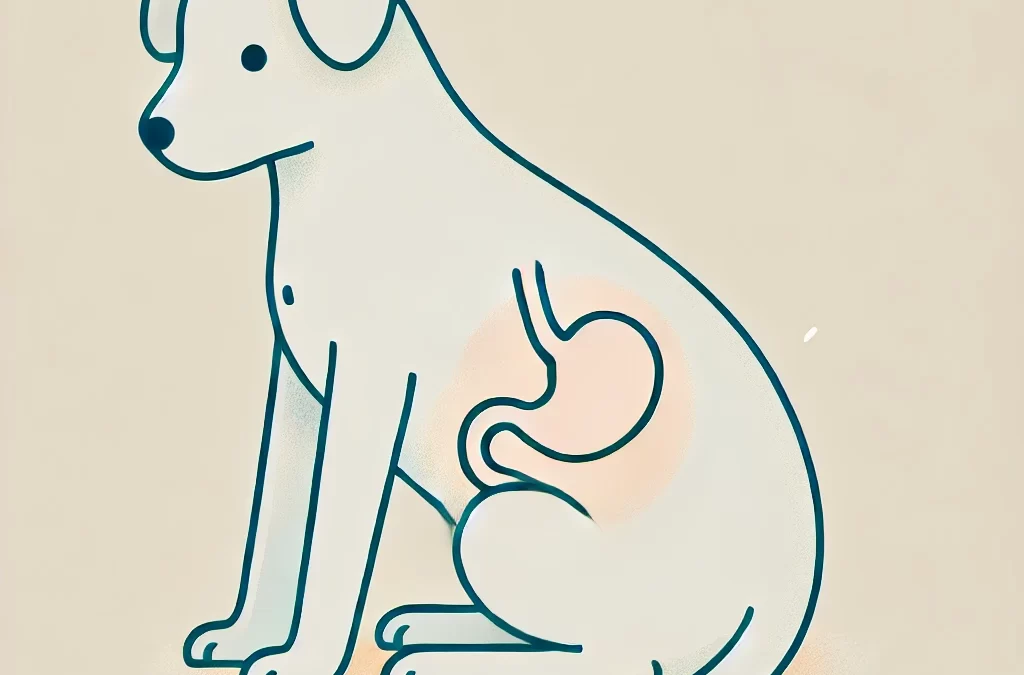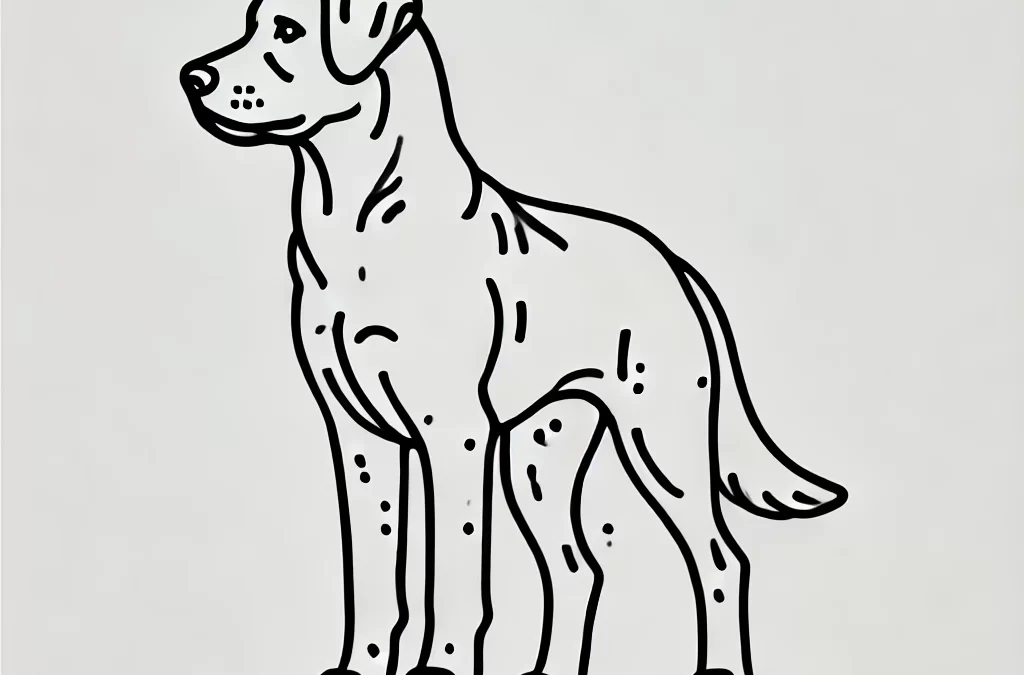
by TCMVET | Nov 11, 2024 | Dog Cancer & Tumors
A diagnosis of a splenic tumor in a beloved dog can be heart-wrenching, as these tumors often pose a serious health risk. However, gaining an understanding of the types of splenic tumors, survival rates, and potential treatments can help dog parents make the best choices for their pet’s wellbeing. In this article, we’ll explore splenic tumors in dogs from a fresh perspective, focusing on the realities and options that can provide both clarity and hope.
1. What Are Splenic Tumors?
- Hemangiosarcoma: A malignant and aggressive tumor type, hemangiosarcoma is unfortunately common in canine spleens and often spreads rapidly to other organs.
- Hemangioma and Splenic Masses: Benign tumors and masses can also form on the spleen. Though these do not spread like hemangiosarcoma, they can rupture, leading to internal bleeding.
- Lymphoma: This type, arising in the lymphatic system, may also affect the spleen, adding complexity to the condition.
2. Recognizing Symptoms Early
- Subtle Symptoms: Splenic tumors are often asymptomatic until they reach an advanced stage. Symptoms may include lethargy, loss of appetite, and weight loss.
- Acute Crisis: In cases where the tumor ruptures, symptoms can escalate rapidly. Pale gums, collapse, abdominal swelling, and labored breathing may signal internal bleeding, requiring immediate veterinary attention.
3. Survival Rates and What They Mean
- Splenic Hemangiosarcoma: With hemangiosarcoma, the prognosis is often guarded due to its aggressive nature. Median survival rates with surgery alone can range from 2-3 months.
- With Chemotherapy: Combining surgery with chemotherapy can extend survival, sometimes offering 6-12 months, depending on the individual dog’s response.
- Benign Tumors and Masses: Survival rates for benign masses are considerably more optimistic, as surgical removal can often provide a complete solution without recurrence.
4. Exploring Treatment Options
- Surgical Intervention: Splenectomy, or removal of the spleen, is the most common treatment for splenic tumors. It can provide immediate relief from symptoms and prevent further complications from a ruptured mass.
- Chemotherapy: This is often recommended for malignant tumors like hemangiosarcoma to control the spread, though it may not be curative. Some dogs tolerate chemotherapy well, showing few side effects.
- Alternative Therapies: Many pet parents explore natural supplements like medicinal mushrooms, which may boost immune function. While these aren’t substitutes for surgery or chemotherapy, they can serve as complementary support.
5. Providing a Good Quality of Life
- Managing Pain and Comfort: Pain management is essential to ensure a good quality of life. Veterinarians often recommend pain relief medications or even acupuncture.
- Diet and Nutrition: Providing a balanced diet rich in antioxidants and immune-boosting supplements can support overall health, especially during treatment or recovery.
- Low-Stress Environment: Minimizing stress through a calm and familiar environment can make a big difference, helping your dog feel comfortable and secure.
6. Why There’s Still Hope
- Promising Research: Ongoing research into canine cancers, especially hemangiosarcoma, may lead to better treatments and outcomes.
- New Therapies: Immunotherapy and targeted treatments are in development, with some showing early promise in trials. Although these are not yet widely available, they offer hope for the future.
- Stories of Resilience: Many dogs with splenic tumors defy the odds and live longer than expected, especially with attentive care and timely treatment.
7. How to Support Your Dog’s Journey
- Veterinary Guidance: Building a strong relationship with your veterinarian is crucial. They can tailor a treatment plan and provide resources for managing your dog’s condition.
- Support Communities: Many online support groups exist for dog parents dealing with cancer, offering encouragement, advice, and shared experiences that can be incredibly uplifting.
Conclusion
Splenic tumors in dogs present unique challenges, but with prompt diagnosis, informed decisions, and compassionate care, many dogs maintain a good quality of life. While survival rates vary, staying proactive and hopeful can make all the difference. Remember, each journey is unique, and by supporting your dog through every step, you’re giving them the love and care they deserve.

by TCMVET | Nov 11, 2024 | Dog Cancer & Tumors
When dog parents discover a lump in their furry friend’s throat, it’s natural to feel concerned. While some lumps may be harmless, others could indicate serious health issues. This article dives into what these lumps might mean, how to identify the concerning signs, and proactive steps to take.
1. Why Do Lumps Develop in Dogs’ Throats?
- Common Causes: Benign growths, such as lipomas or cysts, are often harmless but can sometimes appear near the throat.
- Infections or Inflammation: Swollen lymph nodes could indicate an infection or immune response.
- Tumors: Both benign and malignant tumors can develop in the throat, affecting nearby tissues and organs.
2. Types of Lumps You Might Notice
- Lipomas: Soft and easily movable, usually painless.
- Lymphadenopathy: Swollen lymph nodes that feel firm and are often symmetrical.
- Malignant Tumors: Firm, fixed lumps that may cause discomfort or difficulty swallowing.
3. Recognizing Symptoms Beyond the Lump
- Difficulty Swallowing: This could be an indicator of growth affecting the esophagus or surrounding muscles.
- Coughing or Gagging: If the lump presses against the airway, it could cause respiratory symptoms.
- Change in Appetite or Weight Loss: A serious concern if combined with a persistent throat lump.
4. When Should You Be Concerned?
- Rapid Growth: If the lump grows quickly, it’s essential to have it checked by a veterinarian.
- Pain and Sensitivity: Discomfort or a change in behavior, such as shying away from touch, warrants a closer look.
- Other Symptoms: Unexplained lethargy, persistent coughing, or vocal changes can signal an underlying issue.
5. Diagnosis: What to Expect at the Vet
- Physical Examination: The vet will palpate the area to assess size, texture, and mobility.
- Imaging Tests: X-rays or ultrasound scans provide a view of the lump’s depth and proximity to other organs.
- Biopsy: The most definitive test, where a sample is taken and examined for abnormal cells.
6. Treatment Options
- Watchful Waiting: For benign lumps, the vet may suggest monitoring rather than immediate intervention.
- Surgical Removal: If the lump interferes with daily activities or poses a health risk, surgery is a common choice.
- Natural Supplements and Therapies: Anti-inflammatory supplements or herbal support can benefit some conditions.
- Chemotherapy or Radiation: For malignant tumors, vets may recommend oncology treatments.
7. Prevention and Monitoring
- Regular Check-ups: Routine vet visits can catch unusual growths early.
- Home Monitoring: Gently feel your dog’s throat and other areas for lumps. Keep a log if any changes occur.
- Healthy Diet and Supplements: Nutrient-rich foods and immune-boosting supplements may help reduce the risk of certain tumors.
Conclusion
While finding a lump in your dog’s throat can be unsettling, proactive care and understanding potential causes can bring peace of mind. Always consult a veterinarian for professional advice, and remember that not all lumps are dangerous. By staying vigilant, you’re taking the best steps toward ensuring your dog’s health and happiness.

by TCMVET | Nov 8, 2024 | Dog Cancer & Tumors
Dogs hold a cherished place in our lives, embodying loyalty, companionship, and boundless joy. However, certain breeds are genetically predisposed to cancer, making it a significant concern for many dog owners. Understanding which breeds are more susceptible to cancer and why can help owners be more vigilant and proactive in managing their pet’s health.
The Breeds at Higher Risk
While cancer can affect any dog, some breeds show a higher incidence due to their genetic makeup. Here are a few breeds known to be more prone to cancer:
- Golden Retrievers: One of the most beloved dog breeds, Golden Retrievers, unfortunately, have one of the highest cancer rates. Hemangiosarcoma and lymphoma are particularly common in this breed.
- Boxers: Known for their playful and energetic nature, Boxers are prone to developing mast cell tumors and lymphoma. Early detection and regular check-ups are crucial for this breed.
- Rottweilers: Rottweilers are susceptible to osteosarcoma, an aggressive type of bone cancer. Their large size and genetic predispositions make them particularly vulnerable.
- Bernese Mountain Dogs: This breed is admired for its gentle nature but has a high risk of histiocytic sarcoma. Owners should monitor for any unusual lumps or behavioral changes.
- German Shepherds: Renowned for their intelligence and loyalty, German Shepherds can develop hemangiosarcoma and other cancers. Their large size and genetic line contribute to their predisposition.
Understanding the Genetic Link
The genetic component plays a significant role in why certain breeds are more prone to cancer. Selective breeding, while often aimed at enhancing desirable traits, can inadvertently pass on genes that predispose dogs to various cancers. Genetic mutations, hereditary syndromes, and breed-specific predispositions are factors that contribute to the increased risk.
Recognizing the Signs
Early detection can make a significant difference in treatment outcomes. Here are some key symptoms owners should look out for:
- Unexplained weight loss
- Lethargy or decreased interest in activities
- Persistent lumps or growths
- Changes in eating or drinking habits
- Panting or difficulty breathing, especially at night
Preventive Measures and Proactive Care
While some cancers cannot be prevented, owners can take steps to reduce risks and promote overall health:
- Regular Veterinary Check-Ups: Routine visits can help catch potential issues early.
- Balanced Diet and Exercise: Maintaining a healthy weight and ensuring proper nutrition can support the immune system.
- Genetic Testing: For breeds with a high risk, genetic testing can provide insights into potential predispositions.
- Awareness of Breed-Specific Risks: Knowing the risks allows owners to be more observant and proactive in their care.
A Call for Research and Awareness
Ongoing research into canine cancer aims to better understand the genetic and environmental factors that contribute to these conditions. Awareness campaigns and funding for veterinary oncology are essential in advancing treatment options and preventive strategies.
Conclusion
Owning a dog from a breed that is prone to cancer does not mean inevitable heartache; rather, it emphasizes the importance of knowledge and preparedness. By understanding the risks, recognizing the signs, and maintaining proactive care, owners can provide their beloved companions with a higher quality of life and more precious moments together.

by TCMVET | Nov 8, 2024 | Dog Cancer & Tumors
Dogs hold a cherished place in our lives, embodying loyalty, companionship, and boundless joy. However, when a dog is diagnosed with cancer, the experience becomes an emotional and physical challenge, not just for the animal but for the owners as well. One often overlooked but significant symptom seen in dogs with cancer is panting at night. This behavior, subtle yet distressing, offers insights into the dog’s condition that may guide owners and veterinarians toward better care and management.
The Science Behind Panting
Panting is a natural behavior in dogs used primarily for regulating body temperature. However, when it becomes excessive or occurs at unusual times—such as during the night—it may signal underlying health concerns. In dogs with cancer, nighttime panting can stem from a variety of sources, including pain, anxiety, medication side effects, or disruptions in normal metabolic functions.
Unmasking the Causes
- Pain and Discomfort: Pain is one of the primary reasons a dog with cancer might pant more frequently at night. Certain types of cancer, such as osteosarcoma or aggressive tumors, can cause significant discomfort, which may worsen when the dog lies down or becomes less active.
- Medication Side Effects: Chemotherapy, pain management drugs, or corticosteroids often play a role in cancer treatment but can have side effects. Corticosteroids, for instance, may lead to increased thirst and panting as a result of hormonal changes in the body.
- Anxiety and Restlessness: Cancer can alter a dog’s behavior, leading to anxiety, especially at night when they are left to cope with discomfort in silence. The panting could be a manifestation of restlessness or unease as the dog struggles to find comfort.
- Metabolic Disruptions: Tumors and the associated cancer treatments can affect metabolic processes, leading to an increase in the dog’s respiratory rate. This disruption can trigger panting as the body attempts to maintain balance.
How to Identify When Panting is a Concern
While occasional panting is not necessarily alarming, recognizing patterns can help distinguish between normal behavior and a potential red flag. Owners should take note if the panting:
- Occurs almost exclusively at night
- Persists despite cooling measures, such as a fan or a cooler sleeping area
- Is accompanied by other symptoms such as whimpering, restlessness, or excessive thirst
Steps for Alleviating Nighttime Panting
- Pain Management: Consult your veterinarian about the most effective pain relief options. These may include adjusting the dosage or type of medication to ensure comfort without excessive side effects.
- Calming Techniques: Create a serene environment with minimal disturbances. Calming aids like dog-safe essential oil diffusers, soft music, or anxiety wraps can make a significant difference.
- Review Medication Plans: If panting seems to worsen after starting or changing a medication, discuss alternatives with your vet. Sometimes, minor adjustments can improve the dog’s nighttime comfort.
- Regular Check-Ups: Ensure consistent veterinary visits to monitor the progression of the disease and adjust care plans as needed.
Support Beyond the Symptoms
Nighttime panting is not just a symptom to address—it’s a communication from your dog that they may need extra support. Beyond medical interventions, fostering emotional well-being is vital. Gentle petting, talking to them in a soothing voice, and staying close by during difficult nights can be invaluable.
A Heartfelt Approach to Care
The journey with a dog diagnosed with cancer is unpredictable, filled with both hope and challenges. Addressing symptoms like nighttime panting requires patience, attention, and collaboration with your veterinary team. By understanding the underlying causes and responding with tailored strategies, you can create a more comfortable and loving experience for your cherished companion during this challenging time.

by TCMVET | Nov 8, 2024 | Dog Cancer & Tumors
Introduction
In the vast realm of veterinary medicine, certain conditions lurk in obscurity, eluding even the most seasoned practitioners. Splenic stromal sarcoma in dogs is one such enigma—a rare cancer originating from the connective tissue of the spleen. Unlike the more commonly diagnosed hemangiosarcoma, splenic stromal sarcoma remains a shadowy adversary, often undetected until it reaches an advanced stage.
Rethinking Diagnosis: Beyond the Conventional
Traditional diagnostic methods for splenic tumors rely heavily on imaging techniques like ultrasound and radiography, which may not distinguish stromal sarcomas from other splenic masses effectively. To revolutionize diagnosis:
- Molecular Imaging: Utilizing PET scans with specialized tracers can highlight metabolic activity specific to stromal sarcoma cells.
- Liquid Biopsies: Detecting circulating tumor DNA (ctDNA) in the bloodstream offers a non-invasive diagnostic avenue and real-time monitoring of tumor dynamics.
- Artificial Intelligence (AI): Implementing AI algorithms to analyze imaging data can enhance the detection and characterization of splenic masses, improving diagnostic accuracy.
Personalized Medicine: Tailoring Treatment to the Tumor
The heterogeneity of splenic stromal sarcoma necessitates individualized treatment strategies. Embracing personalized medicine involves:
- Genomic Profiling: Sequencing the tumor’s genetic material to identify mutations and aberrant pathways provides targets for tailored therapies.
- Targeted Therapies: Drugs designed to interfere with specific molecules involved in tumor growth can be more effective and less toxic than conventional chemotherapy.
- Immunotherapy: Stimulating the dog’s immune system to recognize and attack cancer cells offers a promising frontier, leveraging vaccines or checkpoint inhibitors.
Collaborative Research: Bridging Gaps in Knowledge
Advancing our understanding of splenic stromal sarcoma requires a concerted effort:
- Cross-Species Studies: Comparing canine stromal sarcomas with human counterparts can uncover common mechanisms and therapeutic targets.
- Veterinary Oncogenomics Consortia: Establishing collaborative networks to share data and resources accelerates research and fosters innovation.
- Clinical Trials: Encouraging participation in clinical trials expands treatment options for dogs and contributes valuable data to the scientific community.
Ethical Considerations and Owner Involvement
Innovative treatments and research endeavors must be balanced with ethical considerations:
- Informed Consent: Owners should be fully informed about the potential risks and benefits of novel diagnostics and treatments.
- Quality of Life Assessments: Prioritizing the well-being of the canine patient ensures that interventions align with compassionate care principles.
- Data Privacy: Safeguarding the genetic and medical data collected during research protects the privacy of both pets and owners.
Conclusion
Splenic stromal sarcoma in dogs challenges us to push the boundaries of veterinary medicine. By embracing advanced diagnostics, personalized therapies, and collaborative research, we can transform our approach to this rare cancer. This journey not only holds promise for improving outcomes in canine patients but also enriches the broader understanding of sarcomas across species.

by TCMVET | Nov 2, 2024 | Dog Cancer & Tumors
Nasal adenocarcinoma is a type of cancer most commonly found in the nasal passages and sinus areas of older dogs. It tends to grow aggressively in these areas, causing discomfort and respiratory issues, although it rarely spreads to other parts of the body. When it does metastasize, it usually affects the nearby lymph nodes, lungs, or brain. Dogs generally develop nasal tumors at a higher rate than cats, with most cases diagnosed around 10 years of age.
Common Symptoms of Nasal Adenocarcinoma in Dogs
Early detection of nasal adenocarcinoma is essential for effective management. Since this cancer primarily affects the nasal passage, it often causes symptoms that can be mistaken for other respiratory conditions. Key signs to watch for include:
- Persistent nasal discharge (often one-sided, with potential for blood or mucus)
- Sneezing and noisy breathing
- Swelling around the nasal area or eyes
- Increased nasal congestion or difficulty breathing
- Frequent nose-pawing due to irritation
Any of these symptoms that persist or worsen over time should prompt a visit to the veterinarian for further evaluation.
Diagnosis of Nasal Adenocarcinoma
Veterinarians typically start with a physical examination and then may recommend imaging tests like X-rays, CT scans, or MRI scans to get a clear view of the tumor’s location and size. If nasal adenocarcinoma is suspected, a biopsy may be performed to confirm the diagnosis and understand the tumor’s nature.
Treatment Approaches for Nasal Adenocarcinoma
While nasal adenocarcinoma is challenging to treat, certain therapies can help slow its growth an
- Radiation Therapy: The most common treatment for nasal adenocarcinoma, radiation helps shrink the tumor, alleviating symptoms and slowing progression. It is particularly effective in targeting the nasal area.
- Surgical Removal: In specific cases, surgery can be used to remove accessible parts of the tumor, although complete removal can be difficult given the sensitive area.
- Palliative Care: Pain management and supportive care are essential for dogs with advanced nasal tumors, focusing on enhancing their quality of life.
Supporting Quality of Life for Dogs with Nasal Cancer
For senior dogs, maintaining comfort and managing symptoms can make a significant difference. Here are a few ways to support a dog diagnosed with nasal adenocarcinoma:
- Environmental Adjustments: Use air purifiers to reduce dust and other irritants in the air, which can ease breathing difficulties.
- Gentle Exercise: Provide regular but mild exercise to keep your dog active and improve overall wellbeing without overtaxing their respiratory system.
- Nutritional Support: High-quality, easily digestible foods can help support your dog’s immune system and overall health.
Prognosis and Living with Nasal Adenocarcinoma
While nasal adenocarcinoma is aggressive locally, it has a low rate of metastasis compared to other cancers. With timely treatment and appropriate supportive care, many dogs experience an improved quality of life. Understanding the symptoms, diagnosis, and treatment options helps pet owners make informed decisions to give their dogs the best care possible.






